 Over the last couple of months, James Duke and I have been emailing about his work with HDR images in Apple Final Cut Pro X.
Over the last couple of months, James Duke and I have been emailing about his work with HDR images in Apple Final Cut Pro X.
Recently, James wrote of his experiences and I asked his permission to publish them here. As always, both of us are interested in your comments.
Thanks, James, for sharing your experiences with all of us.
Larry
P.S. I made minor text edits in James’ article to improve flow or clarity, and resized his images to allow easier display on the web.
My Winding Road to HDR
James Duke
www.lifestorypictures.com
I work on travel films/videos targeted to on-line viewing. This particular form, with its landscape and architectural shots, can benefit greatly from HDR technology. I have to add that my budget is quite limited.
About 2 years ago I decided to move to HDR shooting, editing and grading. At the time, HDR TV sets just started to sell in earnest, YouTube initiated HDR services and Vimeo was getting ready to do the same.
I acquired a 4K ENG camera (Panasonic DVX 2000) which internally can record 8-bit Log footage and with an external recorder can handle ProRes 422 HQ 10-bit Log. The HDR grading could be done using Black Magic’s Davinci Resolve. In October of 2016, Mystery Box published an excellent five-part paper, “HDR Video”, describing their HDR work and their project workflow.
As I was shooting my Spain travel video, I kept hoping that when I edit, Apple FCP X will catch up with enough HDR functionality and I will not have to learn yet another great, but new, piece of software. First, FCP X introduced Wide Color (Rec. 2020) and then v10.4 got HDR. Also, the new version of Compressor acquired H.265 (HEVC) codec, albeit without hardware acceleration.
Shooting travel videos at most sites of interest in Europe rarely lends itself to a tripod/camera/external recorder combination. So, with DVX200 only 30% of the material was in 10-bit Log. As a result, I can add my voice to the opinion that while 8-bit Log improves dynamic range, to get to a good HDR image one must have 10-bit color. As one might expect, it is especially so with landscape shots. To avoid this tripod limitation, I am now starting to use a Panasonic GH5 4K mirrorless camera with the intraframe internal Log 10-bit recording and excellent stabilization. This camera has an added advantage of not being as conspicuous as an ENG camcorder.
I host my videos on the on-line video hosting sites. I post each film on both Vimeo and YouTube. I connect the stories on my website to Vimeo for a higher quality (used to be higher – I am not sure if it still is) and post the same videos on YouTube for a wider audience.
About the final product and its delivery. Both Vimeo and YouTube host HDR content. At first, to reach a wider audience, one had to produce two versions – HDR and SDR. Now both hosting sites have a reasonable HDR to SDR conversion, but require special attention to metadata (more on this later).
The “bottleneck” for a larger audience is often assumed to be the small installed base of HDR TVs and the practically non-existing computer supporting hardware H.265 decoding and monitoring. The computer limitations are still with us. This year saw a few new LED monitors with improved dynamic range and wider gamut but, as of now, because of burn-in image issues, OLED technology is not used in these monitors. On the other hand, the HDR 10-bit OLED TVs are plentiful and are selling briskly starting at around $1.5K.
The “bottleneck” is in having to use a front-end “box” in addition to the HDR TV. For Vimeo, it is a combination of Apple TV 4K and HDR TV and for YouTube, it is Chromecast Ultra 4K and HDR TV. These combinations, together with setting and learning a Vimeo or a YouTube app inside these front boxes, is currently a serious limitation. I do not have marketing numbers, but one could guess that this environment reduces the HDR audience. It is only reasonable to assume that Vimeo, YouTube and TV manufacturers will eventually simplify the ability to play on-line HDR media.
Initial FCP X Project Setup and Workflow
It is important to note that I am using a second monitor to view HDR media. This monitor is connected to the iMac via ThunderBolt.
The RAID was connected to the iMac’s first Thunderbolt 2 (TB 2) output and “from there” daisy-chained to a HP monitor, while the TV was connected via Thunderbolt to a HDMI 2.0 adapter to the iMac’s second TB 2 output.
NOTE: I am using an HDR TV for color grading because it is the best I can afford. Independent sources, measured LG TV peak brightness between 700 and 820 nits. It is not a reference monitor and it cannot be calibrated to come several miles close to the likes of SONY $45K BVM-X300, but the pictures are gorgeous, and the color is close to DCI-P3. It is very popular and I am also using this TV as my “Target Consumer TV.”
Since this is a consumer TV, it has many HDR picture modes and one should be careful in selecting the mode and settings in which to grade, but that is a whole other story.
My FCP X workflow, as it related to video, was:
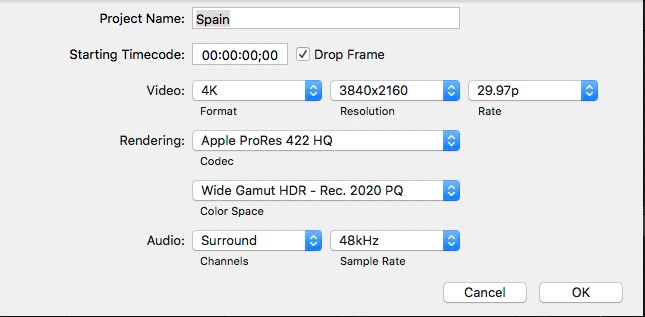
These are the settings I used to setup a new project.

NOTE: When adding an HDR title, I compound a title and then apply a color correction plugin to make title brightness correspond to the PQ-level brightness of the other visuals in the timeline.
Next we need to specify the HDR metadata:
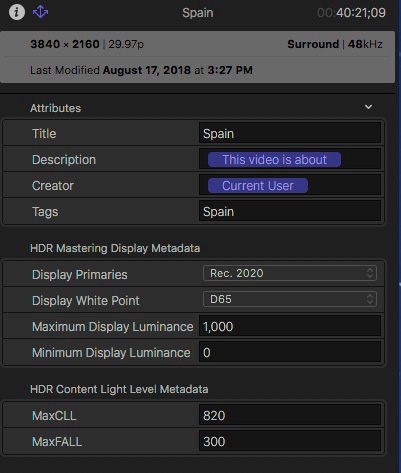
These illustrate the HDR Mastering Display metadata settings I used.
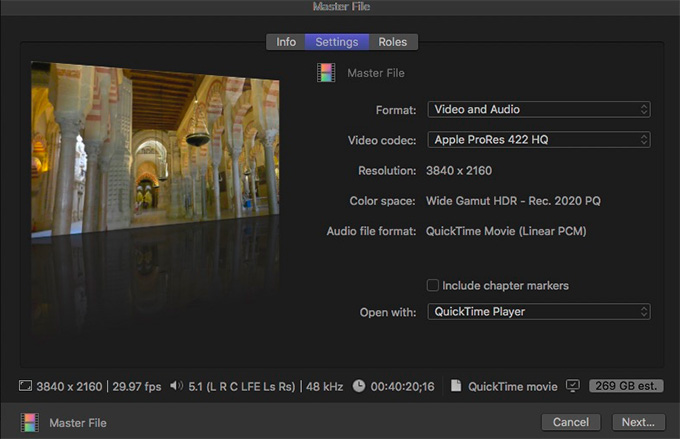
These are the Share export settings I used.
The resulting 40-minute film is about 261 GB in size.
NOTE: When working with HDR media, it is essential you make final color adjustments before outputting the master file.
There were several unexpected results I encountered during primary color grading. To simplify my work, rather than color grading Log clips “from scratch” using FCP X color tools, I started by applying a Camera LUT. As we all do, I try to expose my shots properly and not clip my highlights (unless, I need an effect of some kind).
In fact, the FCP X scopes showed that most of my Log clips were exposed correctly. But after applying the LUT, the bright spots in the FCP X Viewer on both iMac and HP displays appeared overexposed.
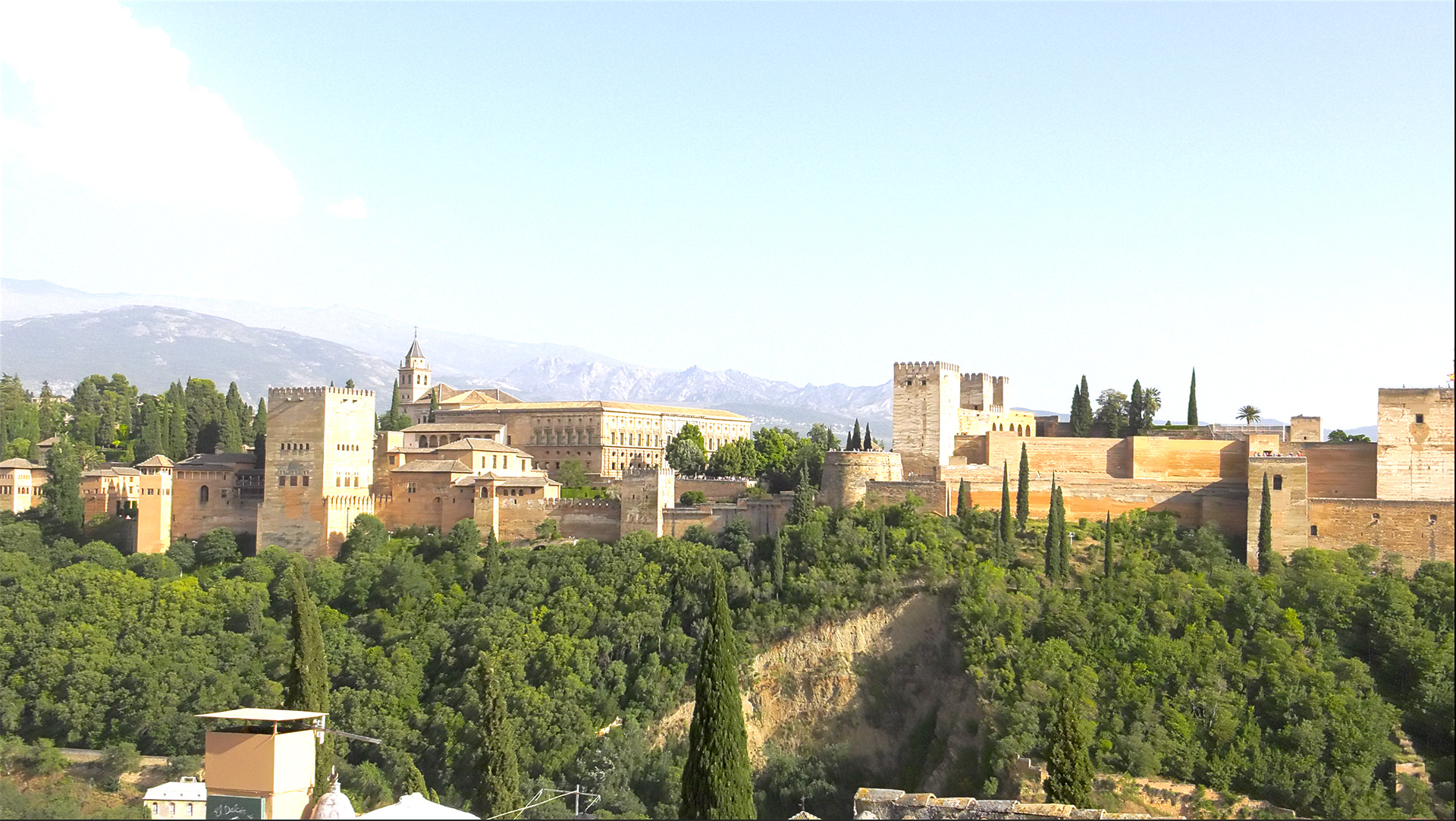
Alhambra, Granada in Spain. Yes, this seems overexposed. Click to see a larger image.

Restaurant Scene Test Image. Yes, this, too, seems overexposed. Click to see a larger image.
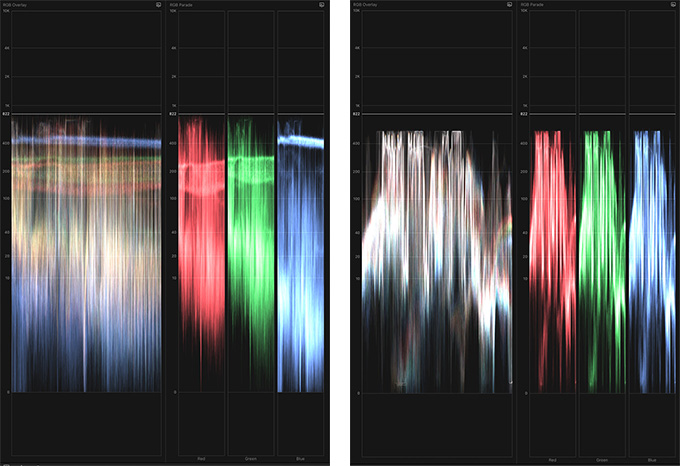
Video scopes for the Alhambra image (left) and restaurant (right). Nothing seems clipped.
Hmmm… For both images, I checked the scopes – nothing was clipped. When I selected the “Show HDR as raw values” check box in Preferences – there was no overexposure in the Viewer. Yet, the images look really bad. What gives?
I decided to finish my Spain film in a “Sub-HDR” form, while resolving the overexposure problem. I graded using “Show HDR as raw values” and the video scopes in FCP X. I was very conservative and kept my video brightness below 300 nits.
In the “Working with Wide Color Gamut and High Dynamic Range in Final Cut Pro X” white paper, Apple states that “In the case of HDR, values above 50.8% signal level (100 cd/m2) for PQ … may appear clipped in the viewer.” When I asked Apple support to elaborate, they indicated that this was beyond what they usually deal with and could not respond.
Larry Jordan kindly agreed to ask his Apple contacts to resolve this enigma. The details are in Larry’s “QuickTime, Final Cut Pro X and HDR” article, but the upshot of the Apple response is that all FCP X viewers are clipped to 100 nits and the A/V Output via TB 2 connector is “unaware” of the HDR signal.
Why would Apple clip their FCP X viewers to 100 nits, when its iMac displays are close to 500-600 nits? So, for now, there’s no HDR monitoring in the Viewer.
That leaves us with the unaware A/V Output via TB 2 connector. Of course, there are “proper” interface boxes which will shape the TB 2 signal metadata and assure HDR monitoring, but they cost more than my HDR TV/monitor.
What if one uses a TB 2 to HDMI 2.0a adapter? HDMI 2.0a is HDR compliant? I tried it. No go. Here is the Gray Scale Step Ramp. It is definitely clipped to 100 nits.
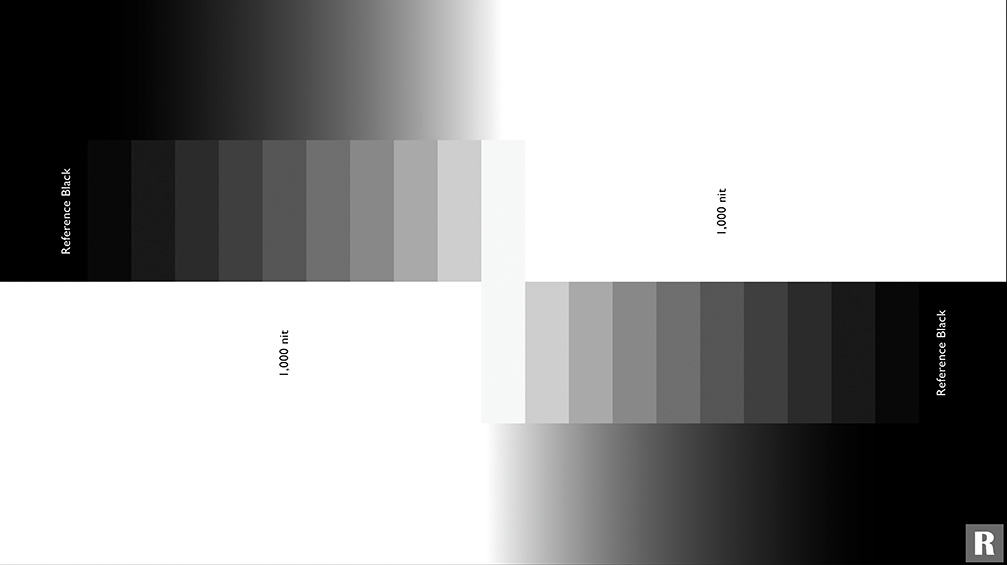
Note the clipping in the highlights, detail above 100 nits lost. Click to see a larger image.
It turns out, that when connecting a second monitor via ThunderBolt 2, or ThunderBolt 3 for that matter, the protocol is unaware of HDR values because both of these standards only include DisplayPort 1.2, but not an HDR-capable DisplayPort 1.4 (Wikipedia on DisplayPort). Next I tried to use HDFury’s Integral box suggested in “HDR Video.” I used its newer cousin Vertex and, although the specs of the device describe the myriad ways to add a HDR metadata to a video signal, I could not make it work properly. Besides, at this point, I was ready to give up and fork over $2.5K for a “proper” interface box.
The proper box will have to be AJA Io 4K Plus. Since I need 4:2:2 10-bit, I need “Plus”, because only on “Plus” a HDMI v2.0 chip can handle 4:2:2 (not 4:2:0) at 10-bit. In addition, since my iMac has TB 2 and the AJA Io 4K Plus has TB 3, I also need a TB 2 to TB 3 adapter. TB 2 on my iMac (as opposed to TB 3) will limit my frame rate to 30, which is OK for now – all my videos are 30 fps.
Black Magic also has an IO device for HDR, but it only displays 8-bit unless you are using DaVinci Resolve.
Note on Camera LUTs in FCP X. Apple has developed the Log to Rec. 2020 LUTs for some of the popular cameras. Apple’s answer to Larry: “…it’s important to note that we’ve worked closely with third-party camera vendors (e.g. Panasonic) to create built-in, color-accurate LUTs (e.g. Panasonic V-Log) for transformation from Log to Rec. 709 or Rec. 2020. This ensures that color conversions in Final Cut Pro accurately adjust the look of the clips recorded in those cameras.”
Some camera manufacturers “stamp” Rec. 709 on all video formats out of the ENG and prosumer cameras (marketing reasons), to leave only the high-end models with possible Rec. 2020 designation. However, it is very well known that the Log footage is not constrained and is a full color gamut out of the camera. In fact, a marketing manager of a major camera manufacturer told me so.
Applying camera LUT, in my case Panasonic V-Log LUT, results in a “proper” Rec. 2020 clip, which only needs to be “shaped” brightness-wise to the PQ level. One just needs to add some saturation and sharpening to finish the process.
After the LUT, applying the Color Space Override -> Rec 2020 PQ setting in the “Show the Info Inspector” pane only changes the clip’s label from Rec. 709 to Rec. 2020, but does not change the video.
My Current Setup
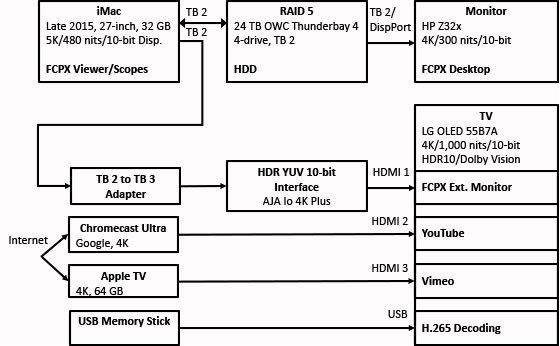
Here’s a flowchart of my current system.
Here are the images when using AJA Io 4K Plus.

Alhambra, Granada with proper HDR values. Click to see a larger image.

The restaurant scene, also with proper HDR values. Click to see a larger image.
Shots do not appear overexposed, because there is no clipping.
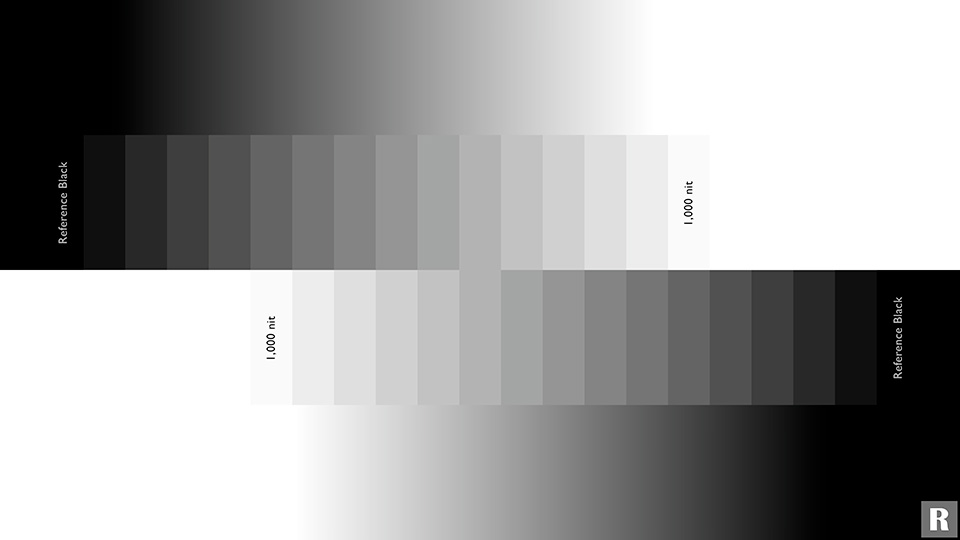
Now, the full gray-scale ramp appears. Click to see a larger image.
With this new setup, when I started to re-grade my Spain project, I am seeing nice HDR results, all the way to 880 nits in some scenes.
Note on getting HDR screen shots. Since the only way to really see my HDR clips is on my LG TV, I had to share a still frame from the FCP X project (it looks dim – iMac does not display HDR) and then “Photoshop-match-it” to the TV image.
Just in case, if you think that after sharing out a ProRes 10-bit HDR file, the QuickTime will come to the rescue and play a “Show HDR as raw values” 10-bit version, I am sorry, no. A QuickTime player can only play an 8-bit dimmed version. The 8-bit “quirk” is confirmed by the Apple answer to Larry’s inquiry.
So, to review this video before compression, I import the video back into a separate FCP X project and view its 10-bit version on LG TV.
I then compress ProRes 422 HQ file using Apple Compressor with the modified 4K (HEVC 10-bit) video settings.
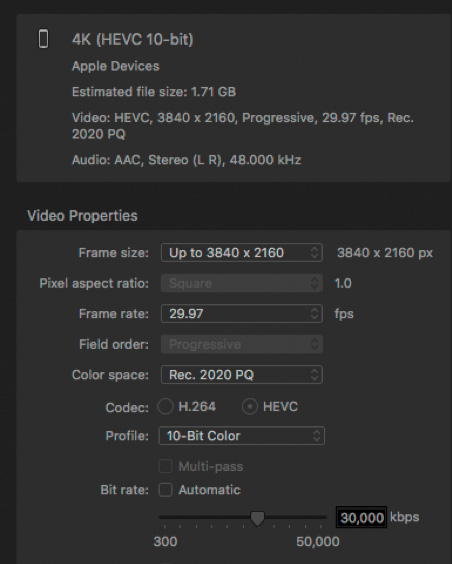
Compression settings in Apple Compressor.
Because the H.265 (HEVC 10-bit) on Mac is software-based compression, it takes 30-40 min to compress each minute of ProRes 422 HQ – result similar to Larry’s test. My 40-minute video took 22 hours yielding a 9.29 GB file.
Uploading to Vimeo and YouTube
The uploading process of a compressed HDR video to Vimeo and YouTube is the same as uploading SDR. The YouTube guidelines do not specify H.265 as an acceptable HDR format, but it works fine.
Here I discovered one more bend in the HDR road.
Even though the HDR image is gorgeous, most of the world is still happily SDR, and, unless one wants to grade two separate versions of each video, the HDR to SDR conversion process of the hosting companies is important. This gets involved, please bear with me.
Vimeo and YouTube do the conversion, but… the resulting video is way too bright. Vimeo’s explanation: “It’s because the PQ curve is based off 10,000 nits, but the SDR version is around 100 nits. When you tone-map (to make SDR), you assign different light level to different pixel values – the higher your peak value is, the more bits you have in lower range, which correspond to the darker colors,” and “When that value is present, we solely rely on MaxCLL for tone-mapping.”
So, I was given advice to “slowly” increase MaxCLL, by say 100, and see when SDR will begin to look “normal.” I had to do a binary ping pong search and my number for MacCLL is 4,000. It is kind of contra intuitive. But, if one overlays three ranges 0 to 100% for SDR, 0 to 1,000 nits and 0 to 10,000 nits for HDR, one will see that the same level of the HDR video brightness will lead to a darker image in SDR for the 0 to 10,000 nit range than for the 0 to 1,000 nit range. The quality of the converted (SDR) video leaves a lot to be desired, and for a really good result one would still need to grade a separate Rec. 709 version.
But, what about an HDR image? Will it not be altered when MaxCLL is 4,000? According to Vimeo it will not: “… adjusting Maximum Content Light Level (MaxCLL) will only affect the SDR version on Vimeo, not the HDR version. We use this metadata to determine the brightness of your SDR version.” I checked both video hosting sites – the 4,000 number does not appear to change HDR video.
All in all, it was an “interesting” road to HDR. If you are curious, you can see my first re-graded 5 min video at vimeo.com/264992227 or www.youtube.com/watch?v=liTP5eeWi0w.
What is your experience with FCP X and HDR?
2,000 Video Training Titles
Edit smarter with Larry Jordan. Available in our store.
Access over 2,000 on-demand video editing courses. Become a member of our Video Training Library today!
Subscribe to Larry's FREE weekly newsletter and
save 10%
on your first purchase.
22 Responses to Working with HDR Media in Apple Final Cut Pro X
Newer Comments →-
 Lou Hemsey says:
Lou Hemsey says:
September 10, 2018 at 5:25 am
-
 Ron Braxley says:
Ron Braxley says:
September 10, 2018 at 6:36 am
-
 SCOTT MARK I says:
SCOTT MARK I says:
September 10, 2018 at 4:47 pm
-
 James Duke says:
James Duke says:
September 20, 2018 at 1:01 pm
-
 thierry says:
thierry says:
October 31, 2018 at 8:26 am
-
 Larry says:
Larry says:
October 31, 2018 at 8:42 am
-
 Christopher says:
Christopher says:
January 24, 2019 at 6:49 am
-
 Charles Hull says:
Charles Hull says:
February 18, 2019 at 8:57 pm
-
 Mark O'Russa says:
Mark O'Russa says:
March 29, 2019 at 6:20 pm
-
 Larry says:
Larry says:
March 29, 2019 at 8:27 pm
-
 Todd Moen says:
Todd Moen says:
July 7, 2019 at 7:21 pm
-
 Larry says:
Larry says:
July 7, 2019 at 7:27 pm
-
 Todd Moen says:
Todd Moen says:
July 7, 2019 at 8:51 pm
-
 Larry jordan says:
Larry jordan says:
July 7, 2019 at 9:49 pm
-
 Chuck Dewitt says:
Chuck Dewitt says:
July 20, 2019 at 11:39 am
-
 Larry says:
Larry says:
July 20, 2019 at 11:45 am
-
 Chuck Dewitt says:
Chuck Dewitt says:
July 20, 2019 at 11:52 am
-
 Rob says:
Rob says:
January 30, 2020 at 8:38 am
-
 Larry says:
Larry says:
January 30, 2020 at 9:45 am
-
 Shane McKenzie says:
Shane McKenzie says:
April 11, 2020 at 2:06 pm
Newer Comments →James/Larry
Thank you for your in-depth tutorial outlining the steps and pitfalls, if you will, on this subject. One again, we are at an ever-increasing “in the middle” between software, hardware, and presentation platforms being somewhat ready to go with slightly differing standards for now.
Nevertheless, we’re all headed there, it’s just when.
Thanks again,
Lou
Lou Hemsey Music and Film
My brain–oh, my brain!
Thanks for the great article with pictures and menus to support your writing.
Just a fantastic real world look into producing HDR content.
Please Keep Posting!
I have re-graded a couple of other videos:
Granada
https://vimeo.com/265000989
https://www.youtube.com/watch?v=nUGloRa01co&t=1s
Cordoba
https://vimeo.com/265039748
https://www.youtube.com/watch?v=SSwsGsbm95c
Thks laarry for all this clarification.
I do exactly like you and use a Aja I/O 4k to output to a LG HDR display and it works fine in HDR
Applying exactly your settings i cannot export a master file including the HDR. it looks like I export a log image with no delog. very weird
Thierry:
Interesting. I don’t have an answer, as I don’t regularly shoot HDR, yet. However, perhaps another reader will have a suggestion. Otherwise, contact Apple Support.
Larry
Thanks for sharing this interesting article I found it most helpful. As I too own a DVX200 and plan to shoot more 10 bit content with it.
There is sort of a solution to the very long rendering times. I first render to ProRes in Compressor in (which is fast), and then re-render the ProRes file in Adobe Media Encoder to 10 bit HEVC. This path is 5 to 10 times faster than Compressor encoding 10 bit HEVC.
ProRes doesn’t support Rec.2020 and likely won’t maintain the HDR metadata. You’ll lose HDR by this method.
Mark:
After additional checking, your statement is incorrect. ProRes is a great format to use when working in wide color gamut HDR. In fact, it’s the format Apple recommends in their “Working with Wide Color Gamut and HDR” white paper:
https://www.apple.com/final-cut-pro/docs/Working_with_Wide_Color_Gamut_and_High_Dynamic_Range_in_Final_Cut_Pro_X.pdf
Larry
Hello Larry and everyone for all this thanks for all the info with this. So many questions pertaining to HDR and how to view it all properly. I’m wondering today what external HDR monitor you all recommend for use with FCX as the tech is changing so rapidly. I’m now shooting HLG which is a Hybrid Log Gamma and creating a project with color space Wide Gamut HDR-Rec 2020 HLG. Thank you very much for your time with this.
Todd:
Thanks for writing. I’m working on a webinar to answer these and other questions: “Using High-End Media” in both Final Cut and Premiere which I’ll present next week. Register here: https://larryjordan.com/weekly-webinar/
In the meantime, email me your questions directly – Larry at LarryJordan dot com – that will give me time to research some answers.
As for monitors, you are right, things are changing quickly. At the moment, I’m leaning toward monitors from Flanders Scientific. They support a variety of HDR formats and are in the “affordable” range. The new, but unreleased, Apple HDR monitor shows a lot of promise, but we won’t know for sure until it ships later this fall.
Larry
Thank you and really appreciate it! I’ll email in some questions.
Those monitors from Flanders look great, but out of my budget range right now.
Todd:
Just so you know. ANY HDR monitor will not be cheap. The technology is too complex to be inexpensive.
Larry
What do you suggest if you have HLG footage (from a GH5s) but now wish to grade and deliver SDR for theatrical projection?
What’s the best workflow to grade in SDR from HLG?
Thanks for this helpful post!
Chuck:
First, I JUST released a new webinar that covers this in detail:
https://larryjordan.com/store/273-using-hdr-media-in-final-cut-pro-x/
Second, drop your HDR footage into an SDR timeline, then apply the HDR Tools effect. Here’s an article that explains more:
https://larryjordan.com/articles/how-to-use-the-hdr-tools-effect-in-final-cut-pro-x-v/
It is straight-forward and will improve your ability to color grade your project.
Larry
Great. Thanks for an instant reply.
So I arrived here by experiencing the “Because the H.265 (HEVC 10-bit) on Mac is software-based compression, it takes 30-40 min to compress each minute of ProRes 422 HQ – result similar to Larry’s test”
It’s now January 2020. Is there a better solution to compressing Pro Res to H265 10bit to preserve HDR. I have a fellow colleague working in Resolve on a PC, and export is fast as it’s using the GPU?
Rob:
I’m not an expert on Windows, but I think your friend is confused.
10-bit HEVC is encoded using the CPU, not GPU. I don’t know of any Intel CPU that supports 10-bit HEVC compression in hardware. (I’m not sure about AMD, however.) Resolve may be using different software acceleration routines than are used on the Mac. Also, 8-bit HEVC is accelerated, while 10-bit is not.
There are a large number of HDR formats that do use the GPU, so it is possible your friend is confusing HDR with HEVC.
Larry
This article is a godsend as I’ve been going round in circles trying to find out the best way of getting the most out of ProRes RAW from the Nikon Z6.
So I gotta ask, did you end up getting the AJA box? In lieu of a fancy expensive monitor, is this the best solution when using a HDR tv as your external monitor?